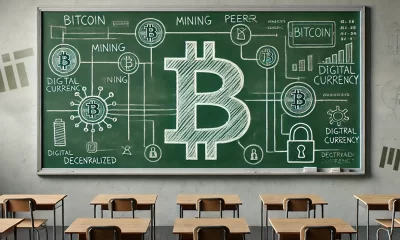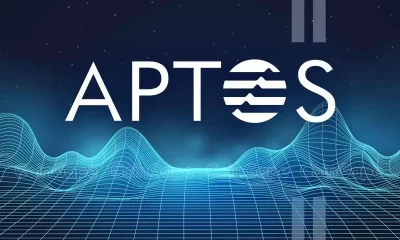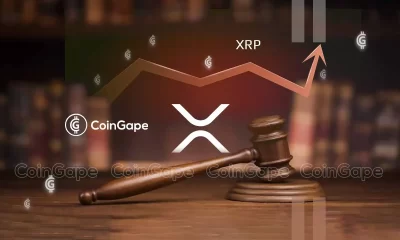DeFi
Usual Protocol activates revenue switch amid redeem function debate
Published
3 months agoon
By
admin
Can Usual’s revenue switch deliver on its promises amid growing concerns?
The Revenue Switch, a mechanism designed to distribute 100% of Usual’s (USUAL) protocol revenue to USUALx stakers, has been launched by the USUAL token and USD0 stablecoin ecosystem creators. While the initiative marks a significant step forward for decentralized finance, its debut is accompanied by ongoing community concerns about recent changes to the protocol’s redeem function.
Activated on Jan. 13, 2025, the Revenue Switch enables USUALx stakers to receive protocol-generated revenue, estimated at $5 million per month, directly in USD0. This mechanism links token value to actual earnings, aiming to incentivize long-term staking and support sustainable protocol growth.
Starting today UTC+0, the Revenue Switch was activated for USUALx holders. Those holding their USUALx positions throughout this week will be eligible for the distribution of last week’s collateral revenues.
More details here & on the dApp: https://t.co/syOdYwHXW5
The 1:1…— Usual (@usualmoney) January 13, 2025
As of Jan. 14, 2025, the USUAL token is trading at $0.5319, with a market capitalization of $275.68 million and a 24-hour trading volume of $194.6 million. Approximately 36.53% of the token supply is staked, offering an annual yield of 275%, 42% in USD0 rewards, and 233% in USUAL.

Despite the excitement surrounding the Revenue Switch, the protocol has faced criticism over its decision to update the redeem function for USD0 stablecoins. The new feature allows for temporary suspension of redemptions under specific conditions, such as during periods of market volatility or liquidity constraints. While USUAL has clarified that this change is intended to maintain stability in extreme scenarios, it has raised concerns about the concentration of control and potential implications for decentralization.
The introduction of the Revenue Switch and adjustments to the redeem function form part of USUAL’s broader strategy to secure its position as a leading DeFi protocol. The Revenue Switch aims to enhance the utility of USUAL tokens, stabilize returns for stakers, and provide a transparent mechanism for revenue distribution. USUAL has also indicated plans to refine its model in the coming months, incorporating advanced staking and governance frameworks inspired by the “veModel” used in other DeFi projects.
As USUAL navigates these developments, the success of the Revenue Switch may serve as a proof of concept for revenue-based tokenomics, potentially influencing future practices in the sector. At the same time, the protocol’s response to community concerns will be closely watched, as it could impact trust and adoption in an increasingly competitive DeFi ecosystem.
Source link
You may like


Bitcoin Trades Above $79K as Asia Markets React to Trump Tariffs


Memecoin platform Pump.fun brings livestream feature back to 5% of users


Bitcoin Price On The Verge Of Explosive 15% Breakout As Analyst Spots Triangle Formation


Strategy CEO Makes The Case For Corporate Bitcoin Adoption In MIT Keynote


Hackers Hammer Android and iPhone Users As Bank Account Attacks Surge 258% in One Year: Kaspersky


Cryptocurrencies to watch this week: Aptos, XRP, Solana
Altcoins
New DeFi Trading Token Definitive (EDGE) Defies Crypto Markets Following Coinbase Listing
Published
3 days agoon
April 3, 2025By
admin
A new decentralized finance (DeFi) trading altcoin is surging after gaining support from the top US-based crypto exchange platform by volume.
In a new thread on the social media platform X, Coinbase says it’s adding the DeFi token Definitive Finance (EDGE) to its suite of digital asset products with an experimental label, causing the altcoin to skyrocket.
Coinbase’s experimental label designates assets as having higher volatility and lower trading volume compared to other products offered by the firm.
News of the addition sent EDGE flying, as the token went from an April 2nd low of $0.0274 to a peak of $0.1157 just a few hours later. The digital asset has since retraced and is trading for $0.086 at time of writing, a staggering gain of nearly 180% during the last 24 hours.
According to its official website, Definitive aims to mimic the experience offered by centralized exchange platforms, such as Coinbase and Binance, despite being decentralized.
“Definitive is the future of onchain trade execution. We deliver a CeFi-like experience on DeFi rails via a fully non-custodial platform and API (application program interface) that is live across Solana, Base and other major EVM (Ethereum virtual machine) chains.
With Definitive, anyone – from a retail user, to a whale, to a liquid fund, or even an AI agent – can trade any asset on any chain with the same institutional-grade execution found in CeFi.”
Follow us on X, Facebook and Telegram
Don’t Miss a Beat – Subscribe to get email alerts delivered directly to your inbox
Check Price Action
Surf The Daily Hodl Mix
 

Disclaimer: Opinions expressed at The Daily Hodl are not investment advice. Investors should do their due diligence before making any high-risk investments in Bitcoin, cryptocurrency or digital assets. Please be advised that your transfers and trades are at your own risk, and any losses you may incur are your responsibility. The Daily Hodl does not recommend the buying or selling of any cryptocurrencies or digital assets, nor is The Daily Hodl an investment advisor. Please note that The Daily Hodl participates in affiliate marketing.
Generated Image: Midjourney
Source link
crypto theft
zkLend hacker loses 2,930 ETH to Tornado Cash phishing scam
Published
6 days agoon
April 1, 2025By
admin

The zkLend exploiter lost all 2,930 ETH in a phishing scam while trying to launder the stolen money using what they thought was Tornado Cash.
According to a Mar. 31 post on X by Consensys-backed De.Fi Antivirus Web3, the attacker mistakenly deposited the stolen funds into a fake Tornado Cash website, resulting in an immediate loss. On-chain data shows that after realizing the mistake, the hacker sent a desperate message to zkLend’s deployer address, admitting their blunder.
“I tried to move funds to Tornado, but I used a phishing website, and all the funds have been lost. I am devastated,” the hacker wrote. They went on to apologize for the attack and urged zkLend to focus its recovery efforts on the phishing scam operators.
BREAKING: ZKLEND HACKER GOT REKT
2,930 $ETH maliciously grabbed in the zkLend hack were mistakenly deposited to a copycat website of Tornado Cash
In the end, the hacker addresses the case to the zkLend deployer as they no longer have stolen assets pic.twitter.com/J9io6vvKYl
— De.Fi Antivirus Web3
(@De_FiSecurity) March 31, 2025
More than $9.6 million in Ethereum (ETH) was stolen in the zkLend exploit, which took place on Feb. 12 . In an attempt to engage in negotiations, the Starknet-based lending protocol offered the hacker a 10% reward in exchange for returning the remaining funds by Feb. 14.
ZkLend was forced to escalate the matter to law enforcement because the hacker ignored the deadline. The platform announced that it had enlisted security experts from the Starknet Foundation, StarkWare, and Binance Security to locate and recover the funds. But now that the stolen ETH has been lost to a phishing scam, things seem to have taken a surprising turn.
The zkLend attack is part of a growing trend of high-profile cryptocurrency exploits. According to Immunefi’s Q1 2025 report, the first three months of 2025 saw the worst quarter for crypto security breaches in history, with hackers stealing $1.64 billion. The zkLend hack was the fifth-largest exploit of the quarter.
Decentralized finance protocols lost $106.8 million across 38 incidents, with Ethereum and BNB (BNB) Chain being the most targeted networks. While DeFi suffered multiple attacks, centralized finance platforms saw just two incidents, but those resulted in a staggering $1.5 billion in losses.
Source link
Bitcoin
BTCFi: From passive asset to financial powerhouse?
Published
1 week agoon
March 30, 2025By
admin
Disclosure: The views and opinions expressed here belong solely to the author and do not represent the views and opinions of crypto.news’ editorial.
Bitcoin (BTC) has always been the face of crypto, the first thing that comes to mind when you think of this market. But for years, its role has been largely static—held as a store of value, yet rarely used for anything else. Then BTCFi entered the scene: unlike traditional DeFi, which has been dominated by Ethereum (ETH) and other smart contract platforms, BTCFi is built around Bitcoin as the core asset.
In the last quarter of 2024, BTCFi’s total value saw a massive surge—from $800 million all the way to $6.5 billion. The momentum is impressive, to say the least. More institutional players are taking notice, and analysts predict that by 2030, roughly 2.3% of Bitcoin’s circulating supply (about $47 billion) could be actively used in decentralized finance.
So clearly, BTCFi is not just a passing trend. But why is it gaining so much traction? Can it really be called the future of Bitcoin’s utility as a financial asset?
Let’s try to figure it out.
What is BTCFi, and why is it growing now?
BTCFi represents the intersection of Bitcoin and decentralized finance, with the first crypto playing the role of the core asset in this case. Typically, DeFi platforms have been built on blockchains like Ethereum, while Bitcoin holders had to wrap their BTC into ERC-20 tokens (like wBTC) to participate in this field.
This kind of tokenization started picking up the pace around 2020, allowing BTC holders to access DeFi services that are typically not available on the Bitcoin blockchain. These “wrapped” tokens are built in a way that makes them compatible with other blockchain networks. And so, they effectively extended Bitcoin’s functionality.
However, advancements in Bitcoin L2 solutions and LRTs, or layered rollup technologies, are now changing the rules. It is becoming unnecessary for Bitcoin to use “second class citizen” ERC-20 tokens anymore.
BTC LRTs, for example, operate on Ethereum and other chains as well, but use Bitcoin as the primary collateral in transactions. This means unlocking the use of Bitcoin as a yield-generating asset in other networks beyond its native chain.
The emerging Bitcoin L2s, meanwhile, are tackling this blockchain’s long-standing scalability issues, allowing for faster and more cost-efficient transactions. These innovations are going to fundamentally redefine Bitcoin, turning it from a passive store of value to an actively utilized financial asset.
Why is BTCFi the gateway for Bitcoin whales in 2025?
Large Bitcoin holders—miners, in particular—have often used CeFi loans backed by their BTCs to fund their operations since they didn’t want to outright sell those assets. This practice is still going on today, but BTCFi promises to make some changes. And that’s where everything will start from, really: by BTCFi enabling new opportunities for Bitcoin holders to put their assets to work.
Soon enough, Bitcoin whales will start looking at BTCFi as a powerful gateway that can be used to enter the DeFi space. And the way I see it, there are two key factors in 2025 that will influence that perception.
The first is the rise of Bitcoin ETFs. BTC ETFs currently account for almost 6% of all Bitcoin supply, having crossed $100 billion in holdings at the beginning of 2025. With them gaining mainstream traction, Bitcoin is increasingly perceived as the safest and most stable cryptocurrency asset.
This makes it a prime choice for DeFi, attracting large-scale holders who want to use their BTC without selling. Earlier in February this year, Goldman Sachs announced that it had invested $1.63 billion in Bitcoin ETFs. That’s easy proof right there.
The second major factor is the appearance of BTC L2 technologies, which we’ve already covered earlier. Until recently, the lack of scalability and transaction efficiency held Bitcoin back from DeFi adoption. Now, we are going to see a surge of L2 solutions that will enhance the network’s performance. And here’s the important part: they will do so while preserving Bitcoin’s core principles of decentralization and simplicity (and, hence, its robustness).
What DeFi platforms need to do for proper BTCFi integration
There are several challenges that will need to be overcome before BTCFi can achieve truly seamless integration. The biggest technical issue will be ensuring that Bitcoin-based L2 solutions become genuinely trustless. At the present time, they are not quite there, often relying on intermediaries and centralized elements, which goes against Bitcoin’s core philosophy.
The good news is that there’s a lot of R&D going on to make it happen. If successful, it could make the vast amounts of BTCs that are currently just lying there “collecting dust” be useful in DeFi.
Another big challenge is going to stem from people’s trust. Among Bitcoin holders, there are many who do not quite trust Ethereum and the existing Bitcoin tokenization methods. The key to winning them over will lie in creating robust and cost-effective solutions on the native Bitcoin network. Having a fully trustless and inexpensive execution layer on the BTC blockchain could really become the dealbreaker for these people.
The future of Bitcoin: More than just ‘digital gold’
For years, Bitcoin has been carrying the moniker of “digital gold”—a safe-haven asset meant for holding rather than using. These days, this is becoming increasingly untrue. As more institutional players enter the crypto space, the potential for BTCFi to become Bitcoin’s next-level evolution is very real.
The demand is on the rise, and the infrastructure is already being built. For Bitcoin whales looking to maximize their assets without selling, BTCFi could become the perfect answer.
Disclosure: This article does not represent investment advice. The content and materials featured on this page are for educational purposes only.

Michael Egorov
Michael Egorov is a physicist, entrepreneur, and crypto maximalist who stood at the origins of DeFi creation. He is a founder of Curve Finance, a decentralized exchange designed for efficient and low-slippage trading of stablecoins. Since the inception of Curve Finance in 2020, Michael has developed all his solutions and products independently. His extensive scientific experience in physics, software engineering, and cryptography aids him in product creation. Today, Curve Finance is one of the top three DeFi exchanges regarding the total volume of funds locked in smart contracts.
Source link

Bitcoin Trades Above $79K as Asia Markets React to Trump Tariffs

Memecoin platform Pump.fun brings livestream feature back to 5% of users

Bitcoin Price On The Verge Of Explosive 15% Breakout As Analyst Spots Triangle Formation

Strategy CEO Makes The Case For Corporate Bitcoin Adoption In MIT Keynote

Hackers Hammer Android and iPhone Users As Bank Account Attacks Surge 258% in One Year: Kaspersky

Cryptocurrencies to watch this week: Aptos, XRP, Solana

This Week in Crypto Games: ‘Off the Grid’ Token Live, Logan Paul ‘CryptoZoo’ Lawsuit Continues

Crypto Liquidations hit $600M as BTC Plunges Below $80K First Time in 25-days

Bitcoin (BTC) Price Posts Worst Q1 in a Decade, Raising Questions About Where the Cycle Stands

Stablecoins are the best way to ensure US dollar dominance — Web3 CEO

Chainlink (LINK) Targets Rebound To $19 — But Only If This Key Support Holds

NFT industry in trouble as activity slows, market collapses

US Tech Sector About To Witness ‘Economic Armageddon’ Amid Trump’s Tariffs, According to Wealth Management Exec

XRP’s Open Interest Surges Above $3 Billion, Will Price Follow?

This Week in Bitcoin: BTC Holds Steady as Trump’s Trade War Wrecks Stocks

Arthur Hayes, Murad’s Prediction For Meme Coins, AI & DeFi Coins For 2025

Expert Sees Bitcoin Dipping To $50K While Bullish Signs Persist

Aptos Leverages Chainlink To Enhance Scalability and Data Access

Bitcoin Could Rally to $80,000 on the Eve of US Elections

Sonic Now ‘Golden Standard’ of Layer-2s After Scaling Transactions to 16,000+ per Second, Says Andre Cronje

Institutional Investors Go All In on Crypto as 57% Plan to Boost Allocations as Bull Run Heats Up, Sygnum Survey Reveals

Crypto’s Big Trump Gamble Is Risky

Ripple-SEC Case Ends, But These 3 Rivals Could Jump 500x

Has The Bitcoin Price Already Peaked?

A16z-backed Espresso announces mainnet launch of core product

Xmas Altcoin Rally Insights by BNM Agent I

Blockchain groups challenge new broker reporting rule

The Future of Bitcoin: Scaling, Institutional Adoption, and Strategic Reserves with Rich Rines

Trump’s Coin Is About As Revolutionary As OneCoin

I’m Grateful for Trump’s Embrace of Bitcoin
Trending

 24/7 Cryptocurrency News5 months ago
24/7 Cryptocurrency News5 months agoArthur Hayes, Murad’s Prediction For Meme Coins, AI & DeFi Coins For 2025

 Bitcoin3 months ago
Bitcoin3 months agoExpert Sees Bitcoin Dipping To $50K While Bullish Signs Persist

 24/7 Cryptocurrency News3 months ago
24/7 Cryptocurrency News3 months agoAptos Leverages Chainlink To Enhance Scalability and Data Access

 Bitcoin5 months ago
Bitcoin5 months agoBitcoin Could Rally to $80,000 on the Eve of US Elections

 Altcoins2 months ago
Altcoins2 months agoSonic Now ‘Golden Standard’ of Layer-2s After Scaling Transactions to 16,000+ per Second, Says Andre Cronje

 Bitcoin5 months ago
Bitcoin5 months agoInstitutional Investors Go All In on Crypto as 57% Plan to Boost Allocations as Bull Run Heats Up, Sygnum Survey Reveals

 Opinion5 months ago
Opinion5 months agoCrypto’s Big Trump Gamble Is Risky

 Price analysis5 months ago
Price analysis5 months agoRipple-SEC Case Ends, But These 3 Rivals Could Jump 500x


